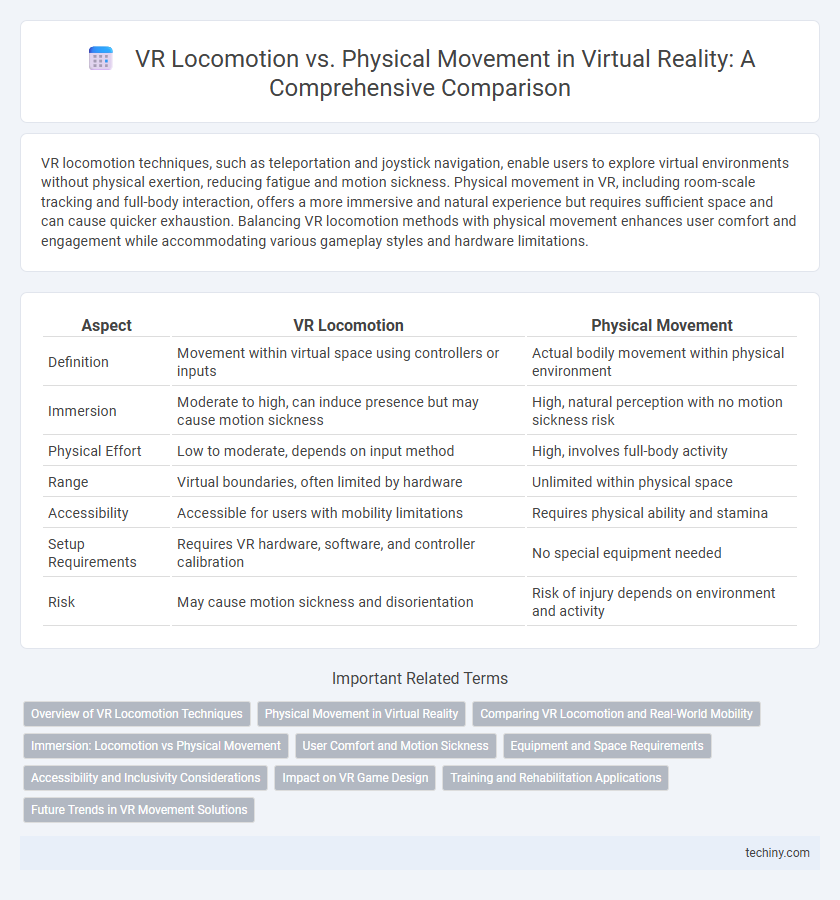VR locomotion techniques, such as teleportation and joystick navigation, enable users to explore virtual environments without physical exertion, reducing fatigue and motion sickness. Physical movement in VR, including room-scale tracking and full-body interaction, offers a more immersive and natural experience but requires sufficient space and can cause quicker exhaustion. Balancing VR locomotion methods with physical movement enhances user comfort and engagement while accommodating various gameplay styles and hardware limitations.
Table of Comparison
| Aspect | VR Locomotion | Physical Movement |
|---|---|---|
| Definition | Movement within virtual space using controllers or inputs | Actual bodily movement within physical environment |
| Immersion | Moderate to high, can induce presence but may cause motion sickness | High, natural perception with no motion sickness risk |
| Physical Effort | Low to moderate, depends on input method | High, involves full-body activity |
| Range | Virtual boundaries, often limited by hardware | Unlimited within physical space |
| Accessibility | Accessible for users with mobility limitations | Requires physical ability and stamina |
| Setup Requirements | Requires VR hardware, software, and controller calibration | No special equipment needed |
| Risk | May cause motion sickness and disorientation | Risk of injury depends on environment and activity |
Overview of VR Locomotion Techniques
VR locomotion techniques encompass a range of methods for user movement within virtual environments, including teleportation, joystick-based navigation, and room-scale tracking. Teleportation minimizes motion sickness by instantly relocating users, while joystick navigation offers continuous movement but may cause discomfort. Room-scale tracking uses physical space to allow natural walking, enhancing immersion but requiring more physical area and setup.
Physical Movement in Virtual Reality
Physical movement in virtual reality enhances immersion by allowing users to naturally navigate virtual environments, improving spatial awareness and reducing motion sickness compared to artificial locomotion methods. Real-world actions like walking, turning, and climbing translate directly into VR, creating a seamless interaction that increases user engagement and presence. Integrating advanced tracking technologies, such as inside-out sensors and motion capture systems, facilitates precise physical movement replication, essential for applications in training, therapy, and gaming.
Comparing VR Locomotion and Real-World Mobility
VR locomotion employs techniques like teleportation, joystick movement, and room-scale tracking to simulate navigation, offering accessibility in limited physical spaces while reducing motion sickness risks. Real-world mobility relies on natural walking, running, and physical interaction, providing intuitive spatial awareness and full sensory engagement. Comparing both, VR locomotion prioritizes safety and convenience in constrained environments, whereas physical movement ensures authentic proprioception and environmental feedback.
Immersion: Locomotion vs Physical Movement
VR locomotion techniques, such as teleportation and joystick movement, can compromise immersion by introducing sensory mismatches and motion sickness, whereas physical movement within tracked play spaces enhances presence by aligning visual and proprioceptive feedback. Full body tracking and room-scale VR systems enable users to physically walk, crouch, or reach, significantly increasing embodiment and spatial awareness. Immersive experiences benefit from minimizing artificial locomotion and maximizing natural physical movement to reduce disorientation and maintain user engagement.
User Comfort and Motion Sickness
VR locomotion methods such as teleportation and smooth walking influence user comfort by balancing immersion and minimizing motion sickness symptoms. Physical movement aligns sensory inputs, reducing sensory conflict that often causes nausea and disorientation in virtual environments. Optimizing VR locomotion techniques enhances user experience by maintaining equilibrium between realistic navigation and comfort thresholds.
Equipment and Space Requirements
VR locomotion methods vary significantly in equipment and space demands, with physical movement systems requiring vast all-encompassing spaces and specialized hardware like omnidirectional treadmills or room-scale sensors. In contrast, controller-based locomotion techniques rely on handheld devices and minimal play area, making them more adaptable to smaller environments. Selecting an optimal VR setup hinges on balancing immersive freedom against practical spatial and equipment constraints.
Accessibility and Inclusivity Considerations
VR locomotion methods such as teleportation, joystick movement, and arm-swinging offer diverse accessibility options compared to solely relying on physical movement, accommodating users with mobility impairments or limited physical endurance. Designing inclusive VR environments requires integrating customizable locomotion settings that reduce motion sickness and allow seamless navigation for individuals with varying abilities. Emphasizing adaptive controls and ergonomic design in VR platforms enhances user experience and broadens accessibility for users of all physical capabilities.
Impact on VR Game Design
VR locomotion methods such as teleportation, smooth walking, and arm-swinging significantly influence VR game design by affecting player comfort, immersion, and spatial awareness. Designers must balance physical movement constraints with gameplay mechanics to minimize motion sickness and enhance user experience, often incorporating adjustable locomotion settings for diverse player preferences. The integration of real-world physical movement enriches immersion but presents challenges in tracking space and hardware capabilities, impacting level design and interaction paradigms.
Training and Rehabilitation Applications
VR locomotion techniques, such as teleportation and joystick control, enable safe and controlled environments for training and rehabilitation, minimizing physical strain while maximizing engagement. Physical movement in VR promotes motor learning by replicating real-world actions, thereby enhancing muscle memory and neuroplasticity in patients undergoing rehabilitation. Combining VR locomotion with actual physical movement optimizes recovery outcomes by balancing immersive experience and physical exertion tailored to individual therapy goals.
Future Trends in VR Movement Solutions
Future trends in VR locomotion emphasize combining physical movement with advanced tracking technologies to enhance immersion and reduce motion sickness. Innovations like omnidirectional treadmills, haptic feedback suits, and AI-driven predictive motion models promise seamless interaction between virtual and physical spaces. These advancements aim to create intuitive VR movement solutions that adapt to user behavior and spatial constraints, unlocking new possibilities for gaming, training, and social experiences.
VR locomotion vs Physical movement Infographic

 techiny.com
techiny.com